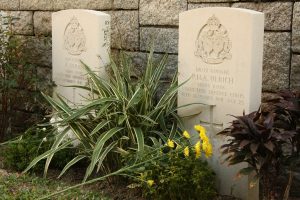Mr. Ulrich, Peter Hans Amandus
Biography

The story of the 2nd President of LSOBA Peter Ulrich (1916 ~ 1941)
Peter Hans Amandus Ulrich was born in 1916 to Peter (Sr.) and Berta (nee Gottsche) Ulrich of Bangkok, Thailand. Peter was a graduate of La Salle College’s class of 1935. Therefore his studies should have commenced before LSC was opened in January 1932, and thus he may have studied in St. Joseph’s Branch School, the forerunner of LSC located in Chatham Road in Tsim Sha Tsui, or in St. Joseph’s College, LSC’s sister school on Hong Kong Island.
In 1935, six government scholarships were awarded to the top matriculation students in Hong Kong. Of the six prizes, LSC took the first three, and Peter was the top student in Hong Kong with six distinctions. Two other Lasallians, Louis Allaye Chan (five distinctions) and Roland Soares (three distinctions), came second and third respectively. Louis was the founding President of LSOBA (the original name of the OBA is La Salle Old Boys’ Association) in 1939.
Peter went on to study in the University of Hong Kong, and after a four year course, he graduated in 1939, and he probably immediately joined LSC as a teacher. A remark from the book ‘Dispersal and Renewal Hong Kong University during the War Years’ by Clifford N. Matthews and Oswald Cheung, mentions that recipients of Government Scholarships were under an obligation to become teachers for a period after their graduation.
Old boys who studied in LSC before the war remember Peter as an all rounded student, and subsequently a passionate staff member. He was always busy with something for the school, and was frequently around the campus long after school hours, coaching students here, or offering help with other activities there. He was much loved by his students.
One year after his former classmate Louis Allaye Chan became the founding President of the LSOBA, Peter received the baton and became the second President of the OBA in 1941.
Meanwhile, all in the Hong Kong colony were tense with the threat of a Japanese onslaught. Many foreigners sent the women and children of the families away from Hong Kong, before the feared attack materialized, and the government passed the ‘Compulsory Service Ordinance’ around June 1939, requiring all male citizens of European extraction and who were of military age to join one of the essential defense services. A grace period was provided to encourage people to join their chosen services voluntarily, after which, those who had not volunteered would be conscripted. The Government Gazette issued on 15th September 1939 reads the name of Peter as being conscripted.
The Commonwealth War Graves Commission records that Peter Ulrich served as a gunner with the 5th Anti-Aircraft (A.A.) Battery of the HK Volunteer Defense Corps (HKVDC). The 5th A.A. was responsible to manage the Anti-Aircraft gun at Sai Wan Fort which is very close to Lyemun (the modern spelling is Lei Yue Mun) Barracks, which have in recently years been converted into to a Park and Holiday Village. The position was a crucial point for the defense of the Hong Kong Island and where the Japanese concentrated their forces. Subjected to constant shelling and bombing since the attacks commenced, the Japanese overpowered the unit.
Eleven days into the Japanese attack of Hong Kong from the New Territories, in the evening of 18th December 1941, at around 9:30 pm, the Japanese finally succeeded in landing on Hong Kong Island. Not long afterwards, the Japanese overran 5th A.A. position. Some 30 men of the unit escaped, leaving behind those wounded or dead from the fighting. Fourteen men from the unit were then captured by the Japanese, and were led out and stabbed one by one. This was the first known massacre carried out by the Japanese in the battle of Hong Kong.
Peter was killed on 18th December 1941, at tender age of 25. Apart from Peter, two other Lasallians in the 5th A.A. were among the twenty killed. They were Peter’s younger brother, Albert Ulrich; and Manuel Heleodoro Ozorio.
The bodies of the twenty soldiers of the 5th A.A. were missing until they were discovered in a trench nearby the unit after the Japanese surrender in 1945. In the book ‘Not the Slightest Chance’, the author, Tony Banham states that out of the twenty dead in the position, six were killed in the initial fighting, thus were not victims in the massacre. It may forever remain a mystery whether old boys Peter, Albert and Manuel belonged to the six or the rest of the fourteen.
Graves of these three old boys, plus Edward Filomeno Hyndman, also of the HKVDC, are in the Stanley Military Cemetery. As a small consolation to those who were dear to the Ulrich’s, Peter’s grave stands side by side with Albert, his brother’s grave. This memoir was published 68 years since the death of Peter, and 15 other war dead old boys and staff, and also one Lasallian Brother, Br. Peter Damian Whealan, and we pray for their souls and for their eternal rest in the house of God. We also pray for those who fought bravely and selflessly to defend Hong Kong.
For your tomorrow, we gave our today.
~ John Maxwell Edmonds, circa WWI Heritage Sub-Committee
LSCOBA
Written in December 2009
PS:The LSCOBA is grateful to Elden Lai (82) who researched into the history of Peter Ulrich and other war dead Lasallians, and who supplied most of the above information.
The photo shows the graves of Peter and his brother Albert in Stanley Military Cemetery.